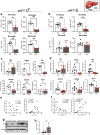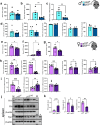Iron metabolism in a mouse model of hepatocellular carcinoma
- PMID: 39820815
- PMCID: PMC11739418
- DOI: 10.1038/s41598-025-86486-x
Iron metabolism in a mouse model of hepatocellular carcinoma
Abstract
Hepatocellular carcinoma (HCC) remains the most prevalent type of primary liver cancer worldwide. p53 is one of the most frequently mutated tumor-suppressor genes in HCC and its deficiency in hepatocytes triggers tumor formation in mice. To investigate iron metabolism during liver carcinogenesis, we employed a model of chronic carbon tetrachloride injections in liver-specific p53-deficient mice to induce liver fibrosis, cirrhosis and subsequent carcinogenesis. A transcriptome analysis of liver carcinoma was employed to identify p53-dependent gene expression signatures with subsequent in-depth analysis of iron metabolic parameters being conducted locally within liver cancers and at systemic levels. We show that all mutant mice developed liver cancer by 36-weeks of age in contrast to 3.4% tumors identified in control mice. All liver cancers with a p53-deficient background exhibited a local iron-poor phenotype with a "high transferrin receptor 1 (Tfr1) and low hepcidin (Hamp)" signature. At systemic levels, iron deficiency was restricted to female mice. Additionally, liver tumorigenesis correlated with selective deficits of selenium, zinc and manganese. Our data show that iron deficiency is a prevalent phenomenon in p53-deficient liver cancers, which is associated with alterations in Hamp and Tfr1 and a poor prognosis in mice and patients.
Keywords: Hepcidin; Iron metabolism; Liver cancer; Trace elements; Transferrin receptor; p53.
© 2025. The Author(s).
Conflict of interest statement
Declarations. Competing interests: The authors declare no competing interests.
Figures





References
-
- Sung, H. et al. Global cancer statistics 2020: GLOBOCAN estimates of incidence and mortality worldwide for 36 cancers in 185 countries. CA. Cancer J. Clin.10.3322/caac.21660 (2021). - PubMed
-
- Llovet, J. M. et al. Hepatocellular carcinoma. Nat. Rev. Dis. Prim.7(1), 6. 10.1038/s41572-020-00240-3 (2021). - PubMed
-
- Li, S. & Mao, M. Next generation sequencing reveals genetic landscape of hepatocellular carcinomas. Cancer Lett.340(2), 247–253. 10.1016/j.canlet.2012.09.027 (2013). - PubMed
Publication types
MeSH terms
Substances
LinkOut - more resources
Full Text Sources
Medical
Molecular Biology Databases
Research Materials
Miscellaneous

